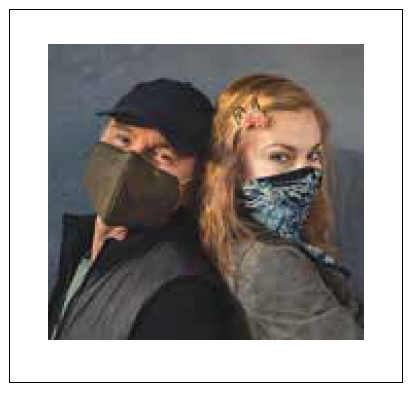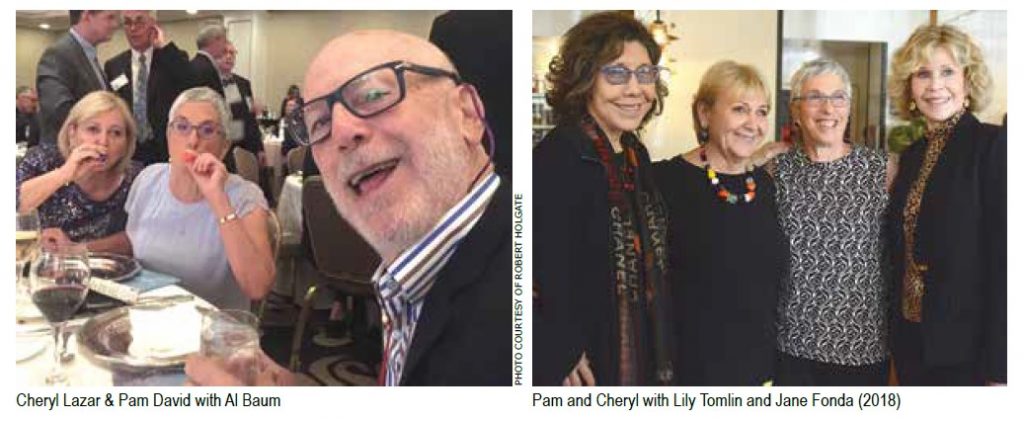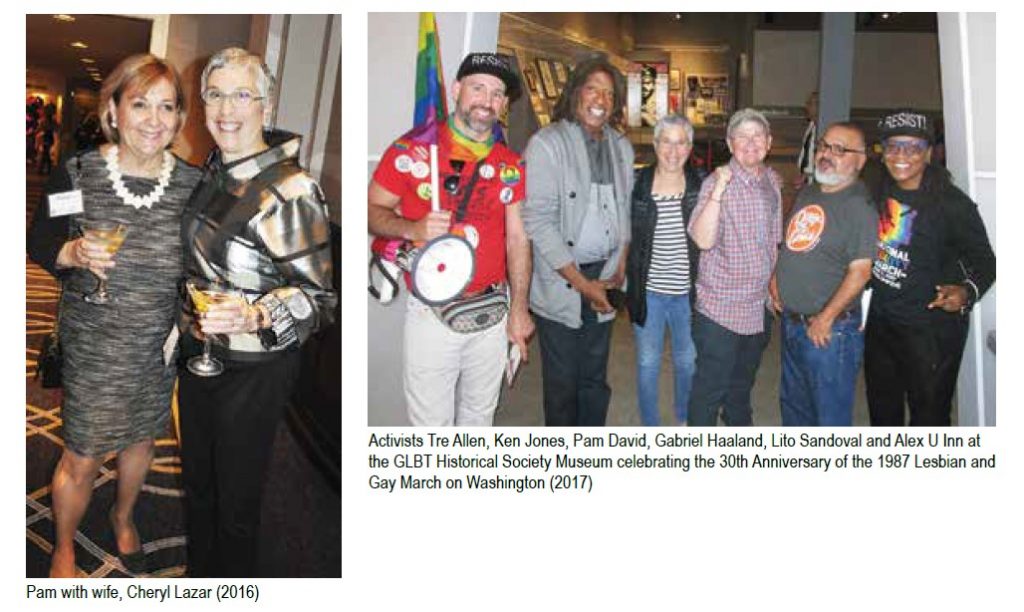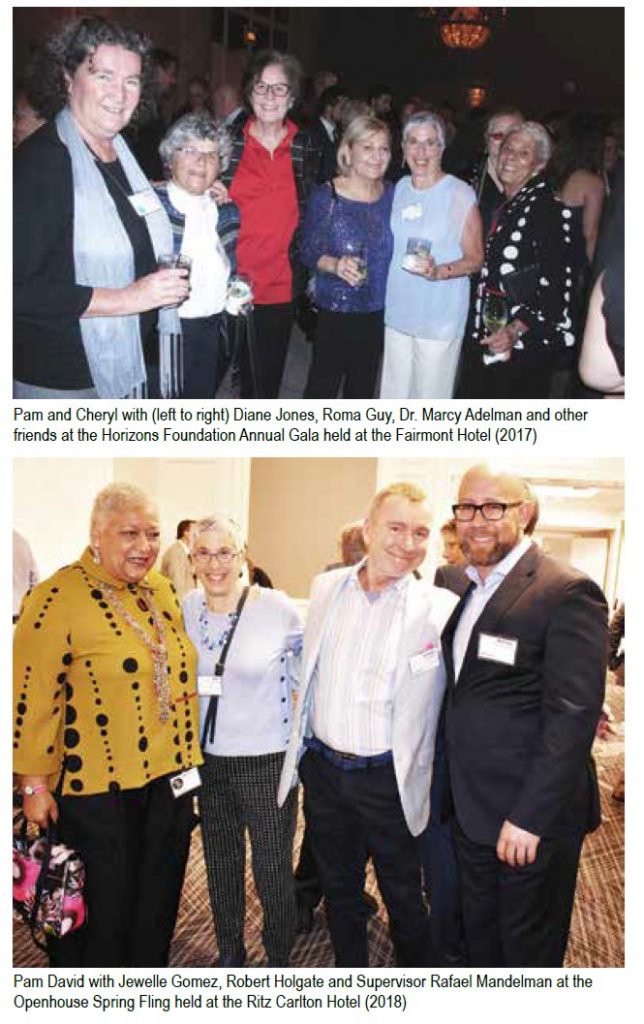
By Robert Holgate and Jennifer Kroot–
“The lesbians have disappeared,” notes Pam David, the lifelong civil rights activist and organizer, who feels she’s not hearing the “L word” as much these days.
Reminiscing with us, Pam describes San Francisco’s vibrant lesbian community that lasted decades, “along the Valencia Street corridor, there was a lesbian presence. I worked at Artemis, a lesbian restaurant. Down the street was a lesbian bookstore, craft store, and women’s bathhouse. On 18th Street was the Women’s Building and Full Moon Coffeehouse. Plus, there were our bars. They’re all gone.”
Pam forged her progressive values as a teenager when her older sister took her to an SDS meeting in 1967. “I became politicized around civil rights and the Vietnam War,” she tells us for the San Francisco Bay Times. “I wanted to protest at the ’68 Democratic Convention, but my parents locked me in the house.” Later, she became a gofer for the Chicago Seven during their trial.

In 1972, Pam was a sophomore at Pitzer College and met Guy Caraway, staff at the Highlander Folk School, a birthplace of the civil rights movement. Pam traveled with him to Appalachia where she spent 9 months living with families and working on issues of strip mining, black lung, and welfare reform. “As a city girl,” she says, “I saw close-up rural poverty and rural racism for the first time.”
At the same time, during a workshop at Highlander, an ex-nun handed Pam the Redstockings Manifesto, introducing her to the feminist movement. Her time in Appalachia cemented her politics, and she remained an activist on her return to California. She also came out (via softball, of course) while in graduate school at Stanford, and then taught at San Francisco State’s Women’s Studies Program.
“San Francisco in the ‘70s felt like a small town, but there was lots going on. As a lefty lesbian, it was very exciting,” Pam recalls. “George Moscone becoming mayor represented a break from the longtime Republican leadership of San Francisco.”

But she had no idea that it was all about to unravel. “We were reeling from the Jonestown massacre, and then Dan White crawled into City Hall and shot George and Harvey,” she says. “The cops protected White. The relationship between the gay community and the police was already fragile, but it exploded. It was the most intense time of my life.”
Pam recalls police raiding the lesbian bar, Peg’s Place. “Lots of people got beat up, so we formed Lesbians Against Police Violence. We did guerrilla theater around town to educate people.”
When White got off on manslaughter charges, Pam joined the street protests, which devolved into the White Night Riots. “It was a police riot, the police instigated the violence,” she remembers. “A group of us stretched along the steps of City Hall. We were peaceful, but they attacked with clubs and tear gas.”
Pam notes that in the early days of the LGBTQ movement, “it was a struggle to put the word ‘lesbian’ into people’s consciousness.” She explains, “As usual, women were invisible. Everything was ‘gay.’ There was the Gay Pride Parade, and gay this and that.”
In 1990, Mayor Art Agnos appointed Pam to the Office of Community Development, which made her the first out lesbian appointed to a San Francisco mayor’s staff. She worked for 3 mayors for twelve years, eventually heading up the office. But, she was dismayed at the rampant misogyny and power plays in City Hall. Offered a position in private philanthropy, Pam left in 2002 to continue her work supporting the nonprofit sector.
Pam has mixed feelings about Newsom’s performance as mayor. “He did some good things, like marriage equality,” she says, “but also fired several great women. But, he’s matured. As governor, he’s brought in some of the smartest, most experienced women I know. And I have a soft spot for him because he officiated my marriage.”
Thinking back, Pam reflects, “We weren’t fans of marriage. The history is about ownership of women, but when the right wing wanted to take it away from us, it pissed me off and I wanted us to be married! Honestly, it validated our relationship in a way I never imagined, even to my mother.”
Pam and Cheryl met in 1986 at Sofia’s, a lesbian bar: “Cher and I had known of each other, but hadn’t ever met, much less talked—and talk we did, as well as dance and laugh. I wasn’t ready for a relationship, and friends were worried I was ‘too political’ for her. But every time we got together it was magic.”

In 2018, Cheryl was diagnosed with cancer. Pam shares she “didn’t want to miss a moment with Cheryl,” so she put her work on hold. Cheryl passed away in July 2020.
Shortly after Cheryl’s death, Pam went to a farmers’ market. “I was the cook in the family, so I always bought for two people. Anyway, I was buying something from a vendor and he asked how much I wanted. I had no idea. I said, ‘I don’t know,’ and burst into tears.”
She says, “It feels like part of me went with her. And part of her is with me, but not in the way I want it to be.” Pam adds, “I don’t think grief is something you get through. Grief changes you, and stays with you always. Because it’s the flip side of love. I plan to love Cheryl forever. So, I will grieve for her forever.”
When Pam left the foundation world, she talked about being “rewired, not retired.” Though taking her time after Cheryl’s death, Pam says she’s not done, but isn’t sure what she’ll do next. Meanwhile, she and her dog, Ruby, are enjoying the outdoors and a quiet, slower pace.
Jennifer Kroot is a filmmaker, known for her award-winning LGBTQ themed documentaries, including “The Untold Tales of Armistead Maupin” and “To Be Takei.” She studied filmmaking at the San Francisco Art Institute, where she has also taught. She is a member of The Academy of Motion Picture Arts and Sciences.
A humanitarian, as well as a designer, Robert Holgate is dedicated to critical social issues. With his hands-on approach to philanthropy and social justice, he supports the advancement of local and national social causes. For more information: https://www.rhdsf.com/.
Published May 6, 2021
Recent Comments